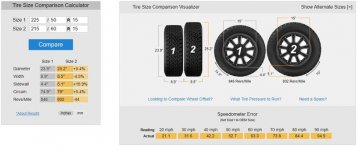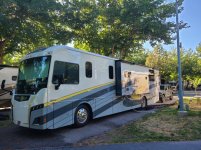We had the Altimax installed, but my impression is that it is not a problem with the tire per se so much as the tire size. Ours is 215/60 R15, which is smaller in diameter than the OEM Kenda, and further feel that the source of the vibration is in the load vs RPM range.
That said, belt tension is roughly 250 and tire pressure is 21 psi, which is down from 29 when it was installed.
Thanks for your impression - I was just wondering about the tire itself being a source of these concerns;
and since many running a/mkt tires still do seem to run slightly higher than ideal pressures, which
can induce 'vibrations', particularly at certain revs/speeds &/or on certain road surfaces (funnily enough, when that sorta vibration happens, it's usually most evident at around 70 - 80 mph!!

), if their chosen pressures might be playing a part in all this?? :dontknow: You can see my earlier post on the pressures tho, so I won't say any more on that.

However, are you sure about
that bit?? :dontknow:
If you used a tire size calculator to work that out, it's not necessarily correct - those calculators will only show/use the '
nominal size' for the entered tire data; and for most I've tried, their results almost always
do not even
exactly match the OEM tire's
actual size vs that printed on the Kenda's sidewall; plus, there's a distinct possibility that the Altimax is also a tire that doesn't exactly match the 'nominal size' from those comparison chart results, so any tire size calculator comparison may be juuust a little misleading at best! And IIRC, most here report that their speedo's became
more accurate after installing Altimax tires (altho which size Altimax they've installed may be also play a part there??) but if that's the case, then like many others have found, your Altimax may well have a
LARGER rolling diameter and so do fewer 'Revs per Mile' than the OEM Kenda, making the speedo show a speed that's a little closer to accurate and your 'true speed'!

Even if you don't/can't go to the manufacturer's details & look at
their 'Revs per mile' spec's (&
not their rolling dia info, cos some manufacturers include the tread layers in their published data; while others use the nominal carcass size; and there are even some manufacturers who seemingly pull a figure outta the air or someone's nether regions for that sort of detail! :cus: ) to confirm that there
actually is a size difference; and if there is, that the slightly narrower Altimax with a higher profile
IS actually
smaller in diameter?!? :dontknow:
Or - Do you run a GPS at all? If so, did your Speedo become
EVEN MORE inaccurate & read even faster speeds than your true speed when compared to the GPS after you installed the Altimax, or did it start displaying speeds a little closer to that reported by the GPS? Using your smartphone & any app/GPS calculation it can do for this sort of speed comparison is better than nothing, but unlike most dedicated GPS units, most phone GPS capabilities aren't really up to reporting speeds all that accurately; so your smartphone
might provide a reasonable indication, or maybe not?! :dontknow:
It's all interesting stuff, but it's quite hard to do any real comparisons via posts on a Forum - still, any detail you can provide helps! Thanks. :thumbup:


